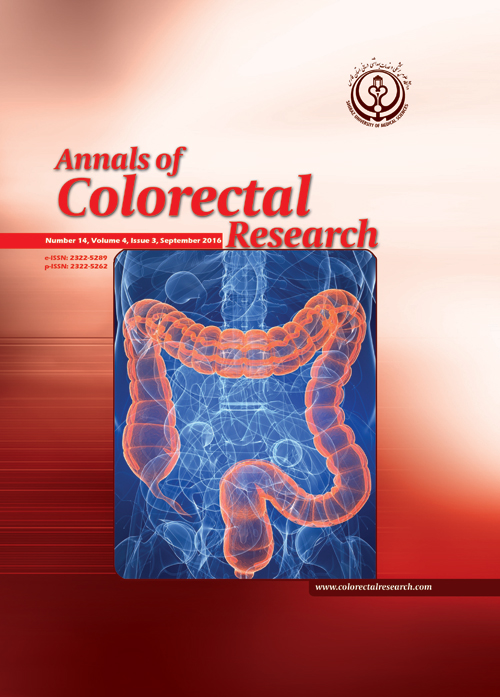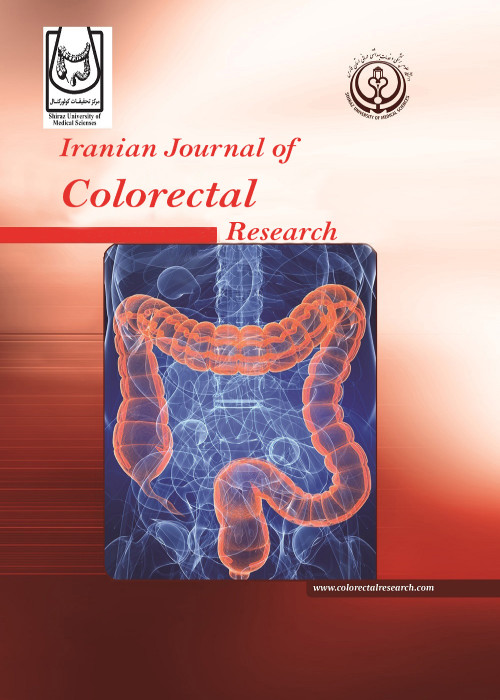فهرست مطالب

Iranian Journal of Colorectal Research
Volume:5 Issue: 3, Sep 2017
- تاریخ انتشار: 1396/07/20
- تعداد عناوین: 5
-
-
Page 1BackgroundColorectal cancer (CRC) accounts for about 10% of cancers and is the third most prevalent cancer worldwide. It is also one of the leading causes of cancer-related mortality. The objective of the current study was to investigate the incidence of CRC East by reviewing reports on number and age standardized incidences of CRC in both genders in different areas of the Middle East.MethodsAll the published reports citing the incidence of CRC in the Middle East were collected by conducting a literature search using Pubmed. Data was extracted from the included articles, and summarized in tables and charts, according to country of origin, gender, and ASR. Data presented by GLOBOCAN on the incidence/prevalence and mortality rates of CRC are also showed in separate charts and tables.ResultsThis research identified 194 articles, through the Pubmed search. After removing duplicate and triplicate publications, 96 full-text articles were assessed for eligibility and 78 were excluded. According to data from Reviewed articles, the highest and the lowest ASR for colorectal cancer were respectively 48.3 (European-American Jews) and 4.2 (Shiraz, south Iran) in males and 35 (European-American Jews) and 2.72 (Shiraz, south Iran) in females (1, 2). According to GLOBOCAN, the highest ASR was 35 (Israel) and the lowest was 4.48 (Yemen) in both genders. Except for Jews, the mean age of patients was 53 to 54.9.ConclusionsAlthough Middle East is generally a low risk region for CRC, the incidence rate of CRC is more in western regions, including countries located on the coast of the Mediterranean sea, compared to eastern and southern regions. Moreover, males and females are at risk at younger ages compared to western countries.Keywords: Incidence, Colorectal Cancer, Middle East
-
Page 2ObjectivesWe aimed to assess the surgical outcomes associated with the introduction of a dedicated colorectal service and newly implemented enhanced recovery after surgery (ERAS) programme at Logan Hospital.MethodsA prospective database was created to include all patients admitted to Logan hospital for colorectal resections after the establishment of a dedicated colorectal service with two colorectal surgical society of Australia and New Zealand (CSSANZ) trained colorectal surgeons and an ERAS programme. The demographics, pathology and surgical outcomes in this patient group were compared to a historical retrospective patient cohort from the same hospital with resections performed by general surgeons prior to the introduction of the ERAS programme. Primary outcomes included the length of stay, readmission rate, morbidity and mortality.ResultsThe prospective database included patients from February to November 2015 with a minimum 30 day follow-up (n = 72). The retrospective patient cohort was from January to December 2012 (n = 68). The average length of stay (LOS) reduced from 10.85 days to 5.74 days (P = 0.037). Thirty day readmission rates decreased from 7.35% to 4.17% (P = 0.485). Morbidity reduced from 41.18% to 11.11% (PConclusionsOur results suggest that a dedicated colorectal service with an ERAS program is able to improve surgical outcomes including length of stay, morbidity and mortality. This is in keeping with existing international literature.Keywords: ERAS, Colorectal
-
Page 3BackgroundDetermining the rate of bactibilia among patients under going laparoscopic cholecystectomy (LC) and its correlations with predisposing factors and postoperative infections, which help evaluate the need for prophylactic antibiotic.MethodsIn this prospective study, 85 consecutive patients with uncomplicated cholelithiasis who underwent LC were enrolled from 2012 to 2013. Routine bile culture was done at the time of LC. Patients were divided into 2 groups, 1 with negative bile culture and another with bactibilia. Demographic and laboratory data were compared. Patients were followed up 10 days after their laparoscopy and 1 month after discharge to monitor the presence of infection.ResultsA total of 7 cultures of bile were positive for bacteria (8.2 %). The patients age was the sole factor with a significant relationship with the rate of bactobilia (P = 0.016). Within 10 days after surgery, fever and surgical site infection were detected in 10.6% of patients, which was not significantly different in the 2 groups. There were no complications in the 30-day follow-up.ConclusionsDetecting bactobilia with low frequency and the lack of correlation between bactobilia and postoperative infectious, complications did not support prescribing prophylactic antibiotic in respective patients. The older age was the sole predisposing factor for the development of bactobilia.Keywords: Bactobilia, Laparoscopic Cholecystectomy, Gallstone, Postoperative Complication, Antibiotic Prophylaxis
-
Page 4BackgroundUlcerative colitis is a common type of inflammatory bowel disease (IBD). The aim of the present study was to examine the relationship between lipid profile, especially high-density lipoprotein (HDL), and malondialdehyde (MDA) level in patients with ulcerative colitis.MethodsIn this study, 45 patients with ulcerative colitis were selected, 25 of whom were diagnosed with active disease and 20 were in clinical remission. Moreover, 45 healthy subjects were selected as the controls. The status of serum lipid profile and MDA level were measured via precise photometric methods. The obtained data were analyzed, using independent t-test and correlation coefficient test. PResultsThe serum level of HDL-C decreased, while the serum level of MDA significantly increased in patients with ulcerative colitis in comparison with the healthy controls (PConclusionsThe inverse correlation between HDL-C and MDA levels can be regarded as an indicator of the protective role of HDL-C against lipid peroxidation in ulcerative colitis. In patients with ulcerative colitis, the serum level of HDL-C decreased in comparison with healthy subjects. Therefore, it is necessary to determine the HDL-C level in patients with ulcerative colitis.Keywords: Ulcerative Colitis Disease, HDL, C Level, MDA Level, Active, Inactive Disease
-
Page 5Diaphragmatic eventration (DE) or eventration of the diaphragm is characterized by a permanent high position of 1 or rarely both the leaflets of the diaphragm, providing a potential space for the displacement of abdominal viscera on the affected side(s).It is a relatively rare condition with unknown etiology in adults. Prevalence of DE is less than 0.05% of the population, both children and adults, and is more common in males. There is a various presentation for DE and patients are mostly asymptomatic. The diagnosis of DE is vital to avoid certain serious, though rare, complications such as gastric or colon volvulus. Here is the report of an unusual presentation of eventration of the diaphragm with sigmoid colon volvulus presented with complaint of chronic constipation and fear to eat. Patient was diagnosed in the operating room despite multiple imaging modalities. Eventration of diaphragm and cachexia is a rare association and to the best of authors` knowledge, it is not reported in literature. It is hoped that the current case report sensitizes physicians to the unusual presentation of eventration of diaphragm.Keywords: Chronic Constipation, Eventration of Diaphragm, Plication of Diaphragm, Mediastinal Shift, Sigmoid Volvulus


